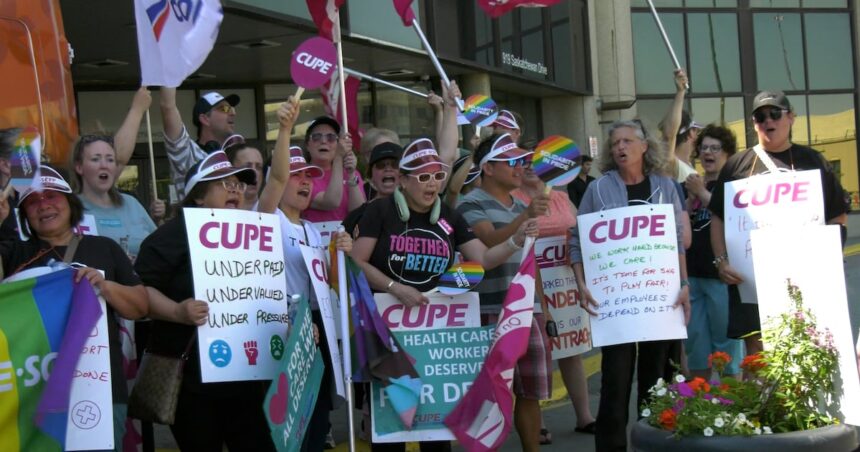As I moved through the crowd gathered outside the Saskatchewan legislature yesterday, the message from health care workers was unmistakable – they’ve reached their breaking point. Nearly 300 nurses, lab technicians, and support staff braved the chilly spring morning, their voices rising in unison above the honking horns of supportive passing motorists.
“We’re stretched beyond thin,” explained Janelle Morris, a registered nurse with 15 years of experience at Regina General Hospital. “Some days I don’t even have time to eat or use the washroom during my 12-hour shift. And the pay doesn’t begin to compensate for what we’re going through.”
The rally, organized by SEIU-West and CUPE Saskatchewan, represents the largest health care worker demonstration in Regina since the pandemic. Workers are demanding a minimum 5% wage increase across the board, improved staffing ratios, and better protections against workplace violence.
Saskatchewan’s health care system has faced mounting pressures in recent years. According to data from the Saskatchewan Health Authority, vacancy rates for registered nurses hover around 18% provincewide, with some rural facilities reporting rates as high as 30%. Meanwhile, overtime hours have increased by nearly 40% since 2019.
Premier Scott Moe’s government has offered a 2% annual increase over three years, which union representatives say falls well short of inflation and fails to address the growing crisis in retention.
“We’re losing skilled professionals to Alberta and British Columbia every month,” said Bashir Ahmed, president of CUPE Saskatchewan’s health care division. “When you factor in the cost of agency nurses at three times the regular hourly rate, it would actually save money to pay our existing staff fairly.”
The protest comes at a politically sensitive time. The Saskatchewan Party government’s popularity has slipped in recent polls, with health care consistently ranking as voters’ top concern. A Mainstreet Research poll from February showed the party trailing the opposition NDP by four points among likely voters, with 62% of respondents rating health care as “poor” or “very poor.”
For workers like Darren Keeping, a medical lab technologist for 22 years, the issues extend beyond compensation. “The workload is unsustainable,” he told me, showing me a schedule with multiple unfilled positions. “We’re processing more samples than ever with fewer people. That increases the risk of errors that could harm patients.”
Health Minister Everett Hindley briefly addressed the crowd, promising to “continue dialogue” but offering no concrete commitments. His appearance was met with calls of “not enough” from several protesters.
The human cost of the staffing crisis was evident in the stories shared during the rally. Emergency room nurse Priya Singh described holding the hand of an elderly patient who waited 14 hours for care. “He kept apologizing to me for being a bother,” she recalled, wiping away tears. “I had to explain that it wasn’t his fault – the system is broken.”
Saskatchewan’s situation mirrors challenges across Canada. The Canadian Federation of Nurses Unions estimates the country is short at least 30,000 nurses nationwide. However, Saskatchewan’s per capita spending on health care ranks near the bottom among provinces, according to the Canadian Institute for Health Information’s 2023 report.
Opposition Leader Carla Beck, who attended the rally, criticized the government’s approach. “This is a crisis of their making,” she said. “Years of underfunding and privatization attempts have hollowed out our public system. These workers deserve more than applause – they deserve proper working conditions and fair compensation.”
Some downtown businesses showed solidarity with the protesters. Coffee shop owner Miguel Reyes offered free drinks to health care workers, saying, “These people took care of us during COVID. Now it’s our turn to support them.”
As the afternoon wore on, workers shared harrowing stories of burnout and moral distress. Many described feeling trapped between their commitment to patients and their own deteriorating mental health.
“I’ve had colleagues end up as patients themselves,” said respiratory therapist William Chen. “The stress and exhaustion eventually take a physical toll.”
Union representatives have set a May deadline for meaningful progress in negotiations before considering escalated job action. While essential services legislation limits full strike options, rotating work-to-rule campaigns remain possible.
For the public, the implications are clear. Longer wait times, delayed procedures, and increased reliance on expensive private staffing agencies will continue without substantive changes.
As the crowd dispersed around 3 p.m., the mood remained determined rather than defeated. Handmade signs reading “Patients Deserve Better” and “Fair Pay Saves Lives” were carefully collected for the next demonstration.
“We’re not giving up,” said Morris as she headed back for an evening shift. “This isn’t just about our paycheques – it’s about saving a health care system that’s on the verge of collapse.”
The government and health authority face difficult choices in the coming weeks. With provincial finances strained by recent resource revenue declines, finding additional funds for health care will require either tax increases or cuts to other services – neither option politically palatable with an election on the horizon.
Meanwhile, for thousands of Saskatchewan residents waiting for surgeries or struggling to find a family doctor, the consequences of this standoff will be measured in more than dollars and cents. It will be measured in pain, anxiety, and lives changed by delayed care.
As one elderly bystander put it, watching the protest from his wheelchair: “I don’t care about the politics. I just want someone to be there when I need help.” It’s a sentiment shared by many across the province, regardless of political stripe.






